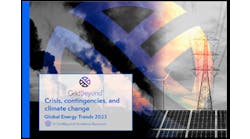By Elisa Wood
October 20, 2010
Lucky for Americans, information technology doesn’t appear to be owned by any one political party. If it were, Congress would still be squabbling over whether or not to support the Internet and you’d be reading this on paper rather than online.
Not so for energy. Generally speaking, Republicans tend to be pro-fossil fuel, while Democrats typically come down on the side of green energy. This feud – which is a key reason Congress cannot pass an energy bill — confuses me. Does a coal-fired plant represent some conservative ideal not found in wind power? What’s liberal about the squiggly light bulb illuminating my desk?
How can electrons be partisan?
Okay, I know I’m over-generalizing and bound to attract admonishments from readers who will point out where liberals are sometimes pro-brown and conservatives pro-green. But I think we’ve seen the debate come down along party lines enough in the United States that my assumption is fair.
That’s why it was intriguing to see the recent report “Pro-Partisan Power,” a combined effort of think tanks on both sides of the political spectrum: the Brookings Institution, Breakthrough Institute and the American Enterprise Institute.
In the words of the report authors:
Today, few issues in American political life are as polarized as energy policy, with both left and right entrenched in old worldviews that no longer make sense. For the better part of two decades, much of the right has speculated darkly about global warming as a United Nations-inspired conspiracy to destroy American sovereignty, all while passing off chants of “drill, baby, drill” as real energy policy. During the same period much of the left has oscillated incoherently between exhortations that avoiding the end of the world demands shared sacrifice, and contradictory assertions that today’s renewable energy and efficiency technologies can eliminate fossil fuels at no significant cost. All the while, America’s dependence on fossil fuels continues unabated and political gridlock deepens, preventing real progress towards a safer, cleaner, more secure energy system. The extremes have so dominated mainstream thinking on energy that it is easy to forget how much reasonable liberals and conservatives can actually agree on…”
The report goes on two make four key recommendations: 1) Invest in energy science and education; 2) Overhaul the energy innovation system; 3) Reform energy subsidies and use military procurement and competitive deployment incentives to drive price declines; 4) Internalize the cost of energy modernization and ensure investments do not add to the [federal] deficit.
The authors say this can be done at a cost of $25 billion, which can be recovered through small fees on imported oil, electric utility surcharges, a very low price on carbon or other means that will not cause great pain to any one group.
You may or may not agree with the recommendations. But it is hard not to be impressed with how the authors suggest we portray energy – not as a battle between left or right, but as a technology play, as innovation. I suspect this is what Rhone Resch, president and CEO of the Solar Energy Industries Association, meant when he said that solar energy is an industry, not an issue, as reported recently in Renewable Energy World North America Magazine.
Americans left or right can’t argue with innovation. It has brought us things we all like, our cell phones, our downloadable music, air conditioning, meals we can heat in minutes, and voices that tell us which way to drive our cars so that we don’t get lost — which all somehow have managed to remain free of any partisan taint.
The full report is available here: http://thebreakthrough.org/blog/2010/10/postpartisan_power.shtml
Elisa Wood is co-author of “Energy Efficiency Incentives for Businesses 2010: Eastern States,” available at www.realenergywriters.com.





